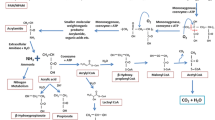Abstract
Acrylamide, a neurotoxic monomer with extensive industrial applications was found to be degraded by the microorganisms present in a tropical garden soil. A bacterium capable of degrading acrylamide was isolated from this soil by enrichment. It was found to be aerobic, gram-negative, motile, short rod and identified as Pseudomonas sp. The bacterium degraded high concentrations of acrylamide (4 g/l) to acrylic acid and ammonia which were utilized as sole carbon and nitrogen source for growth. An amidase was involved in the hydrolysis of acrylamide, which could act on other short chain amides like formamide and acetamide but not on acrylamide analogues: methacrylamide and N,N-methylene bis-acrylamide. The enzyme was sensitive to catabolite repression by succinate both in presence as well as absence of nitrogen source.
Similar content being viewed by others
Abbreviations
- Acrylamide (ACR):
-
High Performance Liquid Chromatography (HPLC)
References
Abdelmagid HM, Tabatabai MA (1982) Decomposition of acrylamide in soils. J Environ Qual 4: 701–704
Alt J, Krisch K, Hirsch P (1975) Isolation of an inducible amidase from Pseudomonas acidovorans AE1. J Gen Microbiol 87: 260–272
American Public Health Association (1976) Standard methods for examination of water and waste water. APHA, New York
Brown L, Rhead MM, Bancroft KCC, Allen N (1980) Model studies of degradation of acrylamide monomer. Water Res 14: 775–778
Brown L, Rhead MM, Hill D, Bancroft KCC (1982) Qualitative and quantitative studies on the insite-adsorption, degradation and toxicity of acrylamide by spiking waters of two sewage works and a river. Water Res 16: 579–591
Buchanan RE, Gibbons NE (eds) (1974) Bergey's manual of determinative bacteriology. William and Wilkins, Baltimore
Chaney AL, Edwards P (1962) Modified reagents for determination of urea and ammonia. Clin Chem 8: 130–132
Cherry AB, Gabbacia AF, Senn HW (1956) The assimilation behaviour of certain toxic organic compounds in natural waters. Sewage Ind Wastes 28: 1137
Clarke PH (1980) The utilization of amides by microorganisms In: Payne JW (ed) Microorganisms and nitrogen sources. John Wiley and Sons, New York, pp 537–562
Collins DH, Lyne PM (1976) Microbiology methods. Butterworths, London
Croll BT, Arkell GM, Hodge RPJ (1974) Residues of acrylamide in water. Water Res 8: 989–993
Dixit R, Mukhtar H, Seth PK, Krishna Murti CR (1980) Binding of acrylamide with glutathione-s-transferase. Chem Biol Interact 32: 353–359
Frankenberger WT Jr, Tabatabai MA (1980) Amidase activity in soils. I. Methods of assay. Soil Sci Soc Am J 44: 282–287
Friedrich CG, Mitrenga G (1981) Utilization of aliphatic amides and formation of two different amidase by Alcaligenes eutrophus. J Gen Microbiol 125: 367–374
Hynes MJ, Pateman JA (1970) The use of amides as nitrogen source by Aspergillus nidulans. J Gen Microbiol 63: 317–324
Igisu H, Goto I, Kawamura Y, Kato M, Izmui K, Kuroiwa Y (1975) Acrylamide encephaloneuropathy due to well water pollution. J Neurol Neurosurg Psychiatry 38: 581–584
Kelly M, Clarke PH (1962) An inducible amidase produced by a strain of Pseudomonas aeruginosa. J Gen Microbiol 27: 305–316
Kelly M, Kornberg HL (1964) Purification and properties of acyltranferases from Pseudomonas aeruginosa. Biochem J 93: 557–566
Lande SS, Bosch SJ, Howard PH (1979) Degradation and leaching of acrylamide in soil. J Environ Qual 8: 133–137
Miller JM, Gray DO (1982) The utilization of nitriles and amides by Rhodococcus sp. J Gen Microbiol 128: 1803–1809
Nishikawa H, Muto Y, Sonada Y, Miyaki Y (1978) Effects of high molecular coagulants on agricultural crops. Gifu-ken Kogyo Gijutsu Senta Kenkyu Hokoku (Jpn) 10: 5–8
Nishikawa H, Hosomura H, Sonada Y, Inagaki S (1979) Behaviour of acrylamide in soil-plant systems. Gifu-Ken Kogyo Gijutsu Senta Kenkyu Hokoku (Jpn) 11: 31–34
Potts JR, Clarke PH (1976) The effect of nitrogen limitation on catabolite repression of amidase, histidase and urocanase in Pseudomonas aeruginosa. J Gen Microbiol 93: 377–387
Prasad DY (1982) Polyacrylamide as a coagulant aid in water treatment. Chem Age India 34: 387–391
Rosenburg A, Alexander M (1980) 2,4,5-Trichlorophenoxy acetic acid (2,4,5-T) decomposition in tropical soil and its co-metabolism by bacteria in vitro. J Agric Food Chem 28: 705–709
Shairashi Y (1978) Chromosome aberrations induced by monomeric acrylamide in bone marrow and germ cells of mice. Mutat Res 57: 313–324
Shanker R, Seth PK (1986) Toxic effects of acrylamide in a fresh-water fish, Heteropneustes fossilis. Bull Environ Contam Toxicol 37: 274–280
Shanker R, Chauhan LKS, Seth PK (1987) The toxic effects of acrylamide on root tip cells of Allium cepa. Cytologia 52: 895–899
Smyth PF, Clarke PH (1975) Catabolite repression of Pseudomonas aeruginosa amidase: The effect of carbon source on amidase synthesis. J Gen Microbiol 90: 81–90
Tilson HA (1981) The neurotoxicity of acrylamide. An overview. Neurobehav Toxicol Teratol 3: 455–461
Verschueren K (1977) Handbook of environmental data on organic chemicals. Van Nostrand Reinhold, New York
Author information
Authors and Affiliations
Rights and permissions
About this article
Cite this article
Shanker, R., Ramakrishna, C. & Seth, P.K. Microbial degradation of acrylamide monomer. Arch. Microbiol. 154, 192–198 (1990). https://doi.org/10.1007/BF00423332
Received:
Accepted:
Issue Date:
DOI: https://doi.org/10.1007/BF00423332




